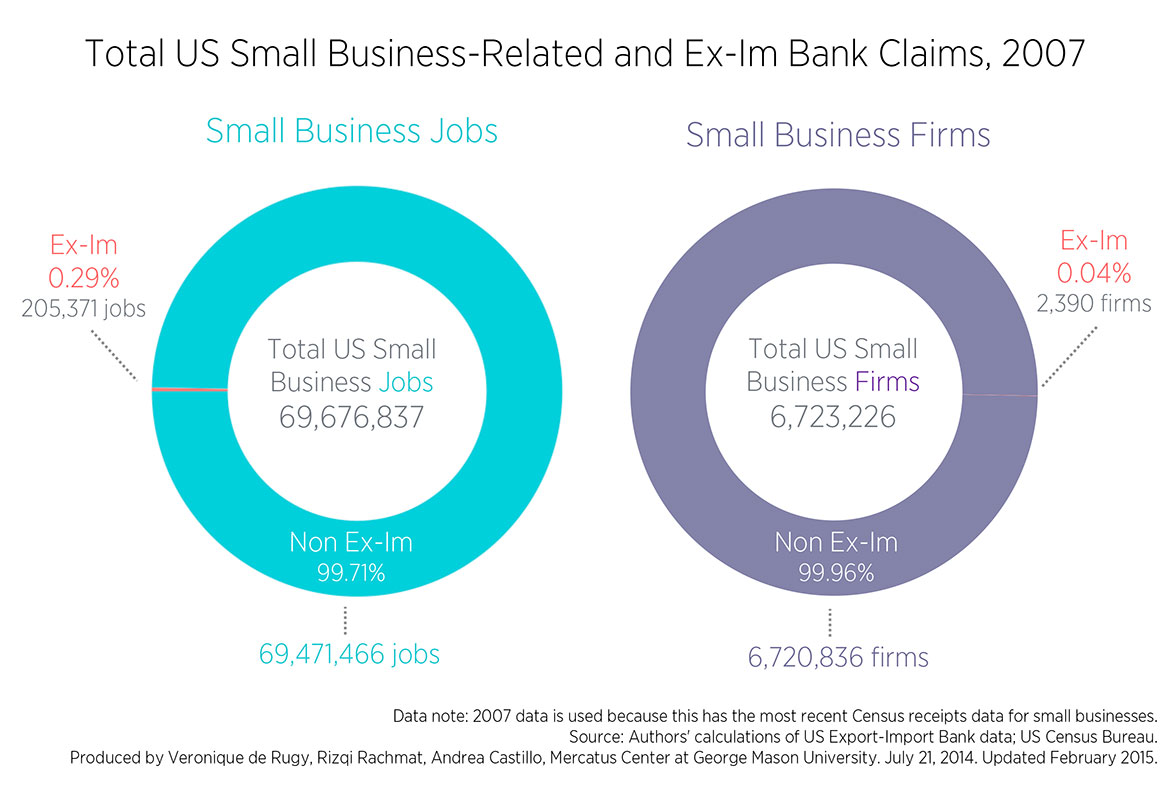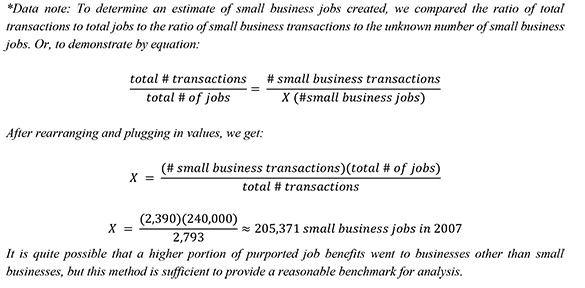- | Government Spending Government Spending
- | Data Visualizations Data Visualizations
- |
The Export-Import Bank Assists a Tiny Portion of All US Small Business Jobs and Firms
These charts show that small business establishments and employees that benefit from Ex-Im Bank assistance constitute a minuscule portion of all small businesses and related employment in the nation. Supporters of the Ex-Im Bank have little reason to claim that it meaningfully benefits American small business firms and their employees.
In an effort to secure the survival of the Export Import Bank, its proponents are drawing attention to its support for small businesses and jobs—and away from allegations of endemic cronyism—by mobilizing small business beneficiaries to pressure legislators and communities to support the Ex-Im Bank’s reauthorization. But, as this week’s chart reveals, the overall effect of the Ex-Im Bank on small business employment and firms is negligible.
This week’s charts use data from the Export-Import Bank and the US Census Bureau to display the Ex-Im Bank’s effect on small business employment and firms in the context of all small business jobs and establishments in America for the year 2007.
The blue chart to the left displays the percent of all US small business jobs that were supported by the Ex-Im Bank compared to all US small business jobs that did not receive such assistance. The purple chart to the right displays the percent of all US small business establishments that were supported by the Ex-Im Bank compared to all US small business establishments that did not receive Ex-Im assistance. We will briefly explain our methods before discussing our results.
We were limited in the datasets that we could use because of the unusually expansive definition of “small business” used by the Ex-Im Bank. The Small Business Administration (and most federal agencies) set the base mark for a small business at firms with under 500 employees. The Ex-Im Bank, on the other hand, includes firms that have up to 1,500 in their definition of “small business.” For this reason, we had to use the Census Bureau’s Statistics of U.S. Businesses (SUSB) dataset for large employment sizes. We summed each variable for all firms that employed less than 1,500 workers and compared these values to those reported by the Export-Import Bank in its annual reports since 2007. (Note: The chart uses data from 2007 as that is the most recent year for which the SUSB data series listed estimated receipts for businesses by employment size was available.)
Unlike its more recent reports, the Ex-Im Bank’s annual report for 2007 does not provide a concrete number of jobs that it claims to have supported that fiscal year. The Bank claims that its activities helped to create or support a total of 1.2 million jobs from FY 2009 to FY 2013, which translates into an annual average of 240,000 jobs. We used this 240,000 average as an estimate of the Ex-Im Bank’s job numbers in 2007. The bank’s internal number may be slightly higher or lower than this estimate, but it is unlikely to be different enough to materially change the analysis.
While the Ex-Im Bank distinguishes between small business and non-small business firms for their reporting on portfolio authorizations and number of transactions, it does not distinguish which jobs were supported for small businesses and which were supported for large corporations. However, we can estimate this breakdown using other data that the bank provides. The Ex-Im Bank reports that it entered into 2,793 total transactions in 2007, 2,390 of which were designated as for small businesses. If we assume, in a back of the envelope calculation,* that jobs created were divided proportionately between transactions, the Ex-Im Bank supported an estimated 205,371 small business jobs in FY 2007.
The blue chart on the left shows that the Ex-Im Bank benefits a negligible portion of all US small business employment. The Census Bureau reports that firms with fewer than 1,500 employees employed 69 million workers in FY 2007. If the Ex-Im Bank supported 205,371 small business jobs in FY 2007, this means that it can only claim to have supported less than one-third of one percent of all small business employment that year.
The purple chart on the right shows that the Ex-Im Bank benefits an even tinier portion of all US small businesses. The Census Bureau reports that there were 6,723,226 establishments that employed fewer than 1,500 workers in FY 2007. The Ex-Im Bank reports that it facilitated 2,390 transactions for small businesses that year. Assuming that each transaction went to a different small business, this means that the Bank only supported 0.04 percent of all small business establishments in 2007.
These charts show that small business establishments and employees that benefit from Ex-Im Bank assistance constitute a minuscule portion of all small businesses and related employment in the nation. Supporters of the Ex-Im Bank have little reason to claim that it meaningfully benefits American small business firms and their employees.


